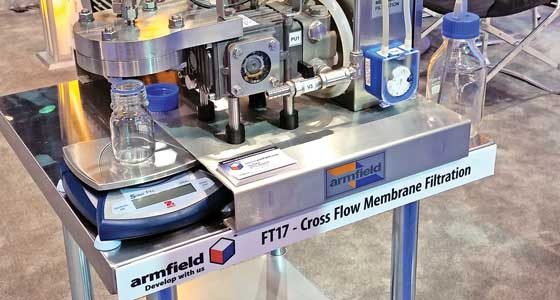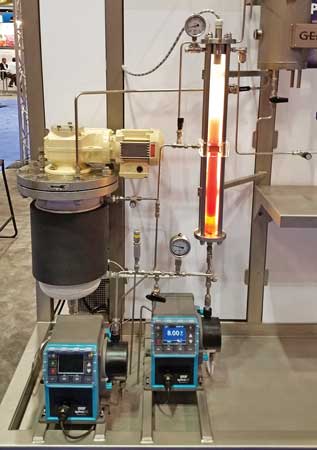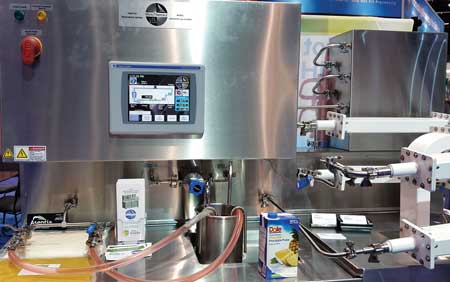A World of Innovation on One Floor
Exhibitors display thermal processing technologies, sanitation solutions, and more.

There are not many expos where you can “walk the world” of innovation in processing/engineering equipment and services as well as ingredients and packaging on one show floor. In this respect, the 2015 IFT food expo was an event to remember; attendees from around the world got a firsthand look at the latest trends, the newest products, and the most recent innovations driving the science of food.
Winning Equipment Options
IFT15 offered ample opportunities for attendees to explore new and cutting-edge developments from exhibitors of processing/engineering equipment and services, including Aseptia Technologies and Ecolab, both winners of the prestigious 2015 IFT Food Expo Innovation Awards.
A panel of jurors from industry, academia, and government selected Aseptia Technologies and Ecolab from 47 qualified entries of companies exhibiting at IFT 2015. Judging criteria included degree of innovation, technical advancement, benefits to food manufacturers and consumers, and scientific merit.
Aseptia Technologies, Raleigh, N.C. (aseptia.com), was honored for its AseptiWave Modular Advanced Thermal Processing Systems, which utilize microwave-assisted advanced thermal processing to deliver superior product quality for aseptically packaged foods and beverages.
Josip Simunovic, Aseptia cofounder and science advisor, had this to say about Aseptia’s 2015 IFT Food Expo Innovation Award: “The Food Expo Innovation Award for AseptiWave advanced processing systems completes an amazing IFT meeting for Aseptia [which was] also recognized with the IFT15 Industrial Achievement Award in collaboration with the North Carolina State University Dept. of Food, Bioprocessing and Nutrition Sciences, while Aseptia’s vice-president of R&D, Pablo Coronel, received IFT’s Industrial Scientist of the Year Award. Recognition by our peers and colleagues provides the additional inspiration and encouragement to continue to innovate and bring more exciting new products and technologies to the commercial marketplace.”
Simunovic continued, “The AseptiWave systems continue to evolve and deliver functionality beyond the primary objective of achieving 10 to 15 months of shelf stability for aseptic and previously refrigerated product categories—without the flavor and nutrient degradation associated with conventional thermal treatments. Typical representatives are fruit and vegetable juices, purees, smoothies, and soups, as well as shelf-stable milk and dairy products. Aseptia partnerships with Sealed Air, MicroThermics, and Amtek continue to grow and generate new installations, applications, and product lines for AseptiWave systems.”
Ecolab, St. Paul, Minn. (ecolab.com), was honored for its DrySan Duo, a two-step, no-rinse cleaner and sanitizer that is designed for dry and low-moisture processing environments. The product reduces cleaning time by eliminating the use of rinse water between cleaning and sanitizing.
The food and beverage processing industry has long wrestled with cleaning and sanitizing in dry-processing environments. Typical solutions are labor intensive and often not optimal in ensuring food safety and quality, productivity, or worker safety. DrySan Duo was designed to address these challenges, helping customers effectively and efficiently provide safe food to consumers.
“Our team continues to work aggressively to develop new and innovative ways to drive food safety solutions throughout the entire food and beverage processing industry,” said Jill Wyant, executive vice president and president of Global Food & Beverage for Ecolab.
In addition to the environmental and cost benefits of eliminated rinse water, plant trials using DrySan Duo showed an average 30% reduction in total cleaning time compared to traditional wet cleaning methods. The trials also demonstrated equivalent performance to traditional wet cleaning utilizing aerobic plate count and Enterobacteriacea test methods.
Processing/Engineering Highlights
According to Andy Kay, head of the Industrial Division for Armfield Ltd., Ringwood, England (explorearmfield.com), his company has been an exhibitor at IFT’s food expo for 22 years. The company designs and manufactures miniature-scale research and development systems for the food, beverage, dairy, oils, and pharmaceutical industries like the modular miniature HTST/UHT process system that was on display at the company’s booth. Armfield’s equipment is designed to replicate manufacturing processes in a laboratory, which enables R&D teams to easily test product formulations.
 One of the demonstration units on display at the impressive GEA Group, Columbia, Md. (gea.com), exhibit was the IceCon for concentrating beer, cider, dairy, whey protein concentrate, and vegetable extracts while maintaining original quality. GEA also offers engineering solutions to retrofit systems or develop completely new plants with a focus on achieving higher yields, greater product diversity, and reducing the total cost of ownership.
One of the demonstration units on display at the impressive GEA Group, Columbia, Md. (gea.com), exhibit was the IceCon for concentrating beer, cider, dairy, whey protein concentrate, and vegetable extracts while maintaining original quality. GEA also offers engineering solutions to retrofit systems or develop completely new plants with a focus on achieving higher yields, greater product diversity, and reducing the total cost of ownership.
 MicroThermics, Raleigh, N.C. (microthermics.com), exhibited its UHT/HTST and aseptic small-scale processors which, combined with the company’s Thermal Process Matching Technology, can be used to accurately mimic plant-scale production in an R&D/lab setting. New products for 2015 on display also included the Food Safety Modernization Act–registered process lab as well as the MicroThermics/Aseptia lab microwave processor.
MicroThermics, Raleigh, N.C. (microthermics.com), exhibited its UHT/HTST and aseptic small-scale processors which, combined with the company’s Thermal Process Matching Technology, can be used to accurately mimic plant-scale production in an R&D/lab setting. New products for 2015 on display also included the Food Safety Modernization Act–registered process lab as well as the MicroThermics/Aseptia lab microwave processor.
According to David Miles, MicroThermics vice-president, “As the industry standard and technological leader in small-scale UHT, HTST, and aseptic processing, our equipment streamlines our clients’ R&D while reducing their costs and time to market. Aseptia’s Aseptiwave technology yields truly fresh-tasting aseptic products with shelf life of up to 12 months or more. We are proud to be partnering with Aseptia to bring their new microwave technology to the R&D labs as they bring it to the production plants.”
Adulterant screen software from PerkinElmer, San Jose, Calif. (www.perkinelmer.com), when paired with PerkinElmer’s Fourier Transform Infrared (FT-IR) and Near Infrared (NIR) spectroscopy instruments, creates a combined hardware and software system that can confirm authenticity and perform nutritional analysis in a single step.
“Food quality professionals face an increasing number of risks related to their ingredients, which need to be continually screened for known contaminants as well as unknown contaminants that may be unsafe substitutions,” said Jon DiVincenzo, president, Environmental Health, PerkinElmer.
Attendees also got an opportunity for a firsthand look at MCT466-SF Food Grade Moisture Sensor from Process Sensors, Milford, Mass. (processsensors.com), which featured a food-grade optical window and a robust stainless steel enclosure. This industrial sensor is said to reliably operate in high-temperature locations, measuring moisture, oil, and product temperatures. The MCT466-SF was featured at IFT alongside the benchtop model MCT466-QuikCheck.
Tipa-Corp Ltd., Hod Hasharon, Israel (tipa-corp.com), exhibited an alternative to conventional flexible packaging for food. Its packaging is biobased, 100% compostable, and said to have the same mechanical properties as ordinary plastic with no adverse impact on product shelf life.
According to Elzaphan Hotam, Tipa-Corp’s vice-president of sales, “Tipa’s solutions combine several desirable properties: transparency and flexibility (the look and feel), and importantly, what’s called a barrier. You don’t want more oxygen and moisture going in and out of the package, which would make the food less crunchy. You need a barrier. In that sense, we can perform as regular plastic.”
All in all, IFT15 was an expo to remember—perhaps even one for the record books of innovation. That record will no doubt stand for a while … at least until IFT16 brings a new wave of innovation to the fore.
Gail Barnes, PhD, a member of IFT, is a partner at Personify LLC, Hoffman Estates, Ill. ([email protected]).
